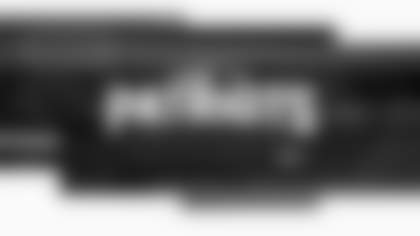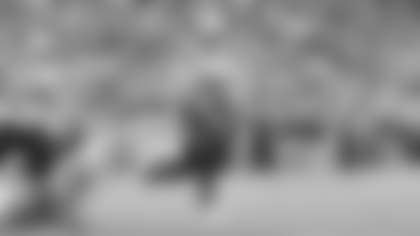Every week now, we begin After Further Review by waxing poetic about the rapid improvement of second-year QB Drake Maye, so why would this week's film review be any different?

Well, we're running out of ways to contextualize Maye's ascension into the franchise quarterback tier. At this point, Maye is on a five-game heater that has him knocking on the door of the post-season accolade conversation (MVP, All-Pro, Pro Bowl, etc.). Pending MNF, Maye is now third in expected points added per drop-back (+0.33), third in completion percentage over expectation (+9.7%), sixth in drop-back success rate (53.3%), and seventh in total QBR (72.0) – a top-10 QB by every metric.
One statistical anomaly was that Maye only had nine deep pass attempts in the first five weeks. Despite the low deep-pass rate, Maye was 7-of-9 while adding +2.15 EPA per drop-back. So, Maye was 28th in pass attempts but first in EPA per drop-back on throws over 20 air yards – just up the volume. On Sunday, Maye's deep ball was finally unlocked, with the Pats QB completing four of his five deep throws for 128 yards and all three touchdowns (and having two nullified by penalties).
The Patriots quarterback also continues to make huge strides in decision-making and ball security. We only had Maye with one "minus" mental error, a red-zone delay of game, while Maye is now tied for 10th-best in turnover-worthy play rate (out of 34 quarterbacks). Maye's turnover-worthy play rate has gone from 3.5% in his rookie season to 2.1% in year two. He's protecting the football in the pocket much better, and the ball is staying out of harm's way more often. The rep above is a great film example. On the play-action drop-back, there's pressure off the left edge, and Maye keeps two hands on the ball and makes the safe throw-away. Last season, that might've been a strip-sack, but his ball security in the pocket has improved leaps and bounds in year two.
Now that we've gushed about Maye's rise to stardom, let's talk about one area of the Patriots offense that needs work: the run game. New England struggled again on the ground with 45 rushing yards on 22 attempts by running backs (2.05 average) while subtracting -0.38 EPA per rush. In the first five weeks, the stats suggested that this was more of a running back issue than a blocking issue. The Pats were sixth in run-blocking win rate and 11th in rushing yards before contact (2.3 yards). However, the Pats backs were 32nd in yards generated after contact (1.5 yards) and avoided tackle rate (9.4%), which suggests they should be a better rush offense.
This week, the Pats generated just 0.7 rushing yards before contact (19 total rushing yards before contact). In other words, the blocking struggled in NOLA. New England majored in more gap runs (13) than zone runs (7), and the Saints were prepared to shoot gaps vacated by pullers. The Pats double teams on duo were generating movement early on, but that also dried up. Another theory that has been floated is that the Pats ball carriers are prioritizing ball security over breaking tackles. On Monday, head coach Mike Vrabel acknowledged that there's some truth to that line of thinking.
"That's something that probably both backs that played yesterday, that carried the ball yesterday, probably are focused on. I think there's a balance there. We've talked about that," Vrabel said. "We'll keep working. We've had some good runs, we've had some pitiful ones, too. We just have to make sure that there's a consistency."
Eventually, the Patriots lack of a running game might catch up to them. As much as they've improved on offense, ranking last in rush EPA and rushing success rate doesn't feel sustainable. From a game-plan perspective, Maye and the Pats wideouts showing off the deep passing game in New Orleans could force defenses to adjust. Entering Week 6, the Pats saw a league-high rate of single-high safety structures (57.2%), meaning there's an extra defender in the box to stop the run. On Sunday, Maye was 11-of-17 for 190 yards and three touchdowns vs. single-high safety defenses.
With the quarterback on this upward trajectory, at what point do defenses have to start lightening the box to protect against the pass? And will that help the Pats run game? The good news is that the Patriots seem to be back in a mode where these are first-world problems. As long as the quarterback continues on this trajectory, New England will have a legitimate chance to make the playoffs.
Here is a review of the defense and quick-hit film notes from the Patriots win over the Saints in Week 6, After Further Review.
Defense Review: Patriots Must Improve Pass Defense to Eye Bigger Goals This Season
With the quarterback playing at an elite level, it's not crazy to start talking playoff paths for the Patriots at 4-2, especially with their future schedule being one of the easiest in the NFL.
However, New England's pass defense must improve to start dreaming big. Although they're stingy against the run (fourth-best in rush EPA), the numbers aren't as friendly to the Patriots pass defense. The Pats are 23rd in drop-back EPA (+0.16), 25th in opponent passer rating (103.8), 31st in drop-back success rate (53.5%), and are allowing a league-high explosive pass play rate of 19.8% (15-plus yards). Note: rankings are pending MNF.
The hope was that getting All-Pro corner Christian Gonzalez back would steady the ship, but the pass defense has only been slightly better with Gonzalez on the field. New England allowed 7.55 yards per pass without Gonzalez in the first three weeks, which has decreased to 6.95 in three games with Gonzalez. Although the yards per pass attempt numbers have improved in man coverage with Gonzo, the Patriots EPA in man coverage is slightly worse (0.33 to +0.40 EPA per play).
Obviously, Gonzalez can't cover all five eligible receivers, so it was unfair to expect him to fix the pass defense single-handedly. Still, when starting CB Carlton Davis combined forces with Gonzalez in the offseason, the expectation was that the pass defense would be a strength of this team. Instead, that hasn't been the case through six weeks.
On Sunday, Saints QB Spencer Rattler's day in the box score looks solid: 20-of-26, 227 passing yards, 102.6 rating. In the first half, Rattler added +0.20 expected points per drop-back with the Saints averaging 8.5 yards per pass play while scoring 16 of their 19 points. The Pats settled down to allow a stingy -0.44 EPA per drop-back and 7.3 yards per pass attempt in the final two quarters, but the film showed too many open receivers.
We can debate what constitutes a pressure or at least meaningful pressure, but NextGen Stats and Pro Football Focus had Rattler under pressure on 46.7% of his drop-backs. In other words, the Patriots pass rush was winning up front but the coverage wasn't tight enough to get the Saints QB to feel the rush. New England majored in zone coverage vs. the Saints, playing zone structures on 70 percent of Rattler's drop-backs (21 of 30). Rattler was 15-of-18 for 194 passing yards against zone, compared to 5-of-8 for 33 yards vs. man coverage. The Pats outside corners played off-coverage 64.7% of the time with an average cushion of 6.5 yards. For comparison, New England played 40.5% off-coverage and only gave Buffalo's receivers 4.8 yards of cushion in Week 5.
The game started with a 53-yard bomb to WR Chris Olave on a zone blitz, where the Patriots blitzed CB Carlton Davis from the short side of the field. New Orleans seemed prepped for the Pats to blitz, probably because Rattler has struggled against the blitz in previous weeks. This week, Rattler didn't struggle, going 6-of-9 for 90 yards when the Patriots blitzed on Sunday.
Along with the deep ball to Olave, the other weaker area was between the numbers. The Saints QB was 10-of-13 for 125 yards throwing into the middle of the field. Opposing quarterbacks are now completing 74.5% of their passes between the numbers against the Patriots defense, mainly by attacking zone-dropping linebackers and safeties in the middle of the field.
For example, the Saints got a drive-starter from old friend Brandin Cooks on their final possession. The Pats seem to be playing this down in cover six (quarter-quarter-half), where the right side of the defense is in quarters while the left side plays it like cover two.
New Orleans runs a dagger concept with the inside vertical clearing out the zone for Cooks to run the deep dig. Gonzalez is playing in a quarters technique with outside leverage, so his primary responsibility is covering a vertical or out-breaking route. Between the numbers, NCB Marcus Jones has the flat while LB Robert Spillane is in a hook zone. When Cooks breaks inside on the dig, the passing lane opens to the dig, and Gonzalez is in an out-leveraged position to make a play on the ball.
Something similar happens here with Olave catching a 15-yard glance route. The Patriots appear to be in cover-three (post-safety) this time. Gonzalez is bailing off the line to stay over the top of a vertical route, while Jones widens into the flat with the slot receiver, opening a huge passing window for Rattler to hit his top wideout on the move for a chunk gain. The short zone distribution leaves them 5-on-3 over the three-receiver side without a zone-dropper in the slant window, leaving Gonzalez in a tough spot given his technique.
Again, the Patriots tightened up defensively when needed. Later in the same drive as the first clip, Gonzalez and Spillane were tighter on the dagger concept to force an incomplete pass on third down. The Pats also got another key third-down stop on a zone blitz where Jones got home to force a 54-yard field goal. One could argue that the soft zone coverages worked by holding the Saints to 19 points. Plus, Rattler deserves credit for four big-time throws and an impressive 91.7 PFF passing grade (out of 100).
Nevertheless, the Patriots need to play tighter coverage so that the pass rush can make a larger impact on the game. The front has a chance to be dominant if it's married with better coverage.
Quick-Hit Film Notes from Pats-Saints After Further Review
Offense
- WR Kayshon Boutte was terrific. Boutte converted two third downs and had two explosive touchdowns of 25 and 29 yards. His ability to finish through contact was on display on his game-sealing back-shoulder fade and the 25-yard TD. His 29-yard TD was a great "burst" corner route to sell a crosser before breaking to the flag. Boutte's situational awareness was also stellar, forcing the Saints to burn a timeout by staying in bounds on a seven-yard out and then landing in bounds on his game-clinching catch. Boutte did the same last week when he stayed in bounds on a hole shot on the Pats game-winning drive. Boutte is making clutch catches with excellent awareness. He is developing into a rock-solid pro.
- WR DeMario Douglas ran an outstanding corner-post on his 51-yard TD. Douglas nodded to sell a corner break, got the post-safety to bite, and then separated – it was one of the best vertical routes by a Patriot receiver in recent memory. Douglas also should've had a 61-yard TD on a broken play and caught a 12-yard screen. The details and effort away from the ball have earned Douglas more targets. He's starting to get them.
- The left tackle play from rookie Will Campbell is a huge improvement from recent seasons. Eventually, though, the bar will need to be higher than "better than 2024" across the board for this team. On Sunday, Campbell was up and down. He allowed four total pressures, mostly losing late to power, where he struggled to anchor and hold his blocks. Campbell also didn't get much push on the Pats first goal-line rush attempt on a double-team with LG Jared Wilson, and missed a backside cutoff block on an outside zone stuff. Again, it's passable and clearly not holding the passing game back, but it's fair to raise the standard.
- LG Jared Wilson is also riding the rookie rollercoaster. He allowed three total pressures (PA pull, inside-out double swipe, inside spin) and was on the scene for four run stuffs. Wilson has flashes in pass protection and has good movement skills, but his power is inconsistent. The two rookies on the left side had some shaky moments in the run game on Sunday.
- RG Mike Onwenu only allowed one pressure but was on the scene for three run stuffs. He had a nice double-team block with RT Morgan Moses early, but the Pats need Onwenu to generate more movement on his base/doubles and block on the move more consistently.
- RT Morgan Moses had a nice, quiet day with one hurry allowed and one half-stuff working a double-team with Onwenu. He got called for a false start, but Moses continues to settle down right tackle for the Patriots.
- C Garrett Bradbury had an aborted shotgun snap on fourth down, allowed a QB hit to NT Davon Godchaux, and got beat by a swim move on a run TFL. Bradbury has given up more pressure in pass protection in the last three weeks (five total pressures since Week 4).
- WR Stefon Diggs didn't have the production compared to the last two weeks, but he caught two key passes vs. man coverage: an 11-yard crosser and a 14-yard slant on fourth down. Diggs's ability to get open quickly vs. man coverage has been huge for the Pats late-down offense. It's a big reason they've been so good this season on third and fourth down. Diggs also had a 51-yard "late hands" go ball wiped out by OPI.
- Quieter day for the Patriots tight ends, but TE Hunter Henry had a third-down conversion on a bootleg play to move the chains. TE Austin Hooper allowed a hurry in play-action pass pro, while the tight ends have sometimes had a role in the run-game struggles.
- RB TreVeyon Henderson was the more effective of the two backs with a 2.56 average yards after contact, a 9-yard check-down, and a solid blitz pickup on Boutte's first TD. Henderson had one outside rep that he almost broke, but he just couldn't squeak through the C-Gap. He got some good double-teams early for a total of five successful runs. Although it wasn't explosive, it was a step in the right direction for Henderson.
- RB Rhamondre Stevenson didn't get much help from his blocking, with more yards after contact (19) than total rushing yards (18). Stevenson is a downhill runner at his best with a head start. They have to get him through the first level unblocked to generate YAC. Stevenson cut down LB Demario Davis on a blitz to help Maye get out on his 20-yard scramble.
- Two tough catches by WR Mack Hollins on curls in zone windows. He presented a QB-friendly target and boxed out zone defenders on his back to make both grabs in some traffic.
- WR Kyle Williams drew a 21-yard pass interference, but appeared to be on a different page with his route conversion than Maye, leading to an incomplete pass. Williams' play speed shows up on film. Let's give it some time for the route-running details to click.
- QB Pressures: Campbell (4), Wilson (3), one each (Moses, Bradbury, Onwenu, Hooper, Stevenson).
Defense
- As for the run defense, the Saints had a small handful of successful scripted runs. However, New Orleans success rate (38 percent) and EPA per rush (-0.06) were only slightly above average with their longest run being a nine-yard scramble by Rattler. The schemed runs that gave New England some issues were a successful GT Counter bash (7 yards), a zone-read keeper by Rattler (8 yards), and Taysom Hill's goal-line touchdown on a crack sweep. It's worth noting that the QB-designed runs were successful for potential matchups down the road against mobile quarterbacks (Fields, Dart, Allen, Lamar).
- CB Marcus Jones is on a two-game heater and has now made plays on five different passes over the last few weeks. Jones had three third-down PBUs in this game, including an outstanding "play the hands" from out-of-phase breakup on a slot-wheel that saved a TD. That's an incredibly difficult route to cover in man coverage.
- EDGE K'Lavon Chaisson also showed out in the state where he played college football. Chaisson had eight total pressures and drew a hold. He brought out his go-to double swipe for two different pressures, one on each tackle. He was effective on stunts and cornering the edge in 1-on-1 pass rush. It was good to have him back in the mix this week.
- Rookie S Craig Woodson had his best game of the season. He flies downhill with good play speed and physicality, logging three run stuffs and a pressure on a blitz. Woodson also stayed over the top of a designed shot play for WR Rasheed Shaheed. You're starting to see week-to-week improvement from the first-year safety.
- NT Khyiris Tonga continues to be my favorite Patriot defender to watch on film. He's walking centers back into ball carriers on outside zone, drawing holds, using his bull rush to dent pockets, and absorbing or splitting double teams. My guess is that his 47.1% snap rate is to keep the 335-pound Tonga fresh because his impact is felt tremendously when he's on the field – a great find by the personnel staff.
- DT Christian Barmore was again effective in his 36 snaps, even with running mate Milton Williams under the weather. Barmore held his ground well on interior doubles/combos in the run game, logged two pressures on stunts, had a win on a punch-rip move, and had a run TFL.
- DT Milton Williams played through an illness and was asked to play out of position some. With the Pats short-handed on the edge, Williams logged seven snaps at defensive end when captain Harold Landry left the game for a short time. Williams still had a pressure on an interior bull rush and strung out a jet sweep playing 4-3 end, an impressive rep for a bigger guy, and logged a run stuff on an interior run.
- LB Robert Spillane has come into his own as a run defender. He plays blocks and condenses space with good physicality, while showing some range when the ball "spills" to the outside. Spillane has really turned a corner as a tackler after some early-season struggles. That said, Rattler was 10-of-13 for 125 yards throwing into the middle of the field. At times, the windows when receivers break into the middle from the perimeter are too large, leaving out-leveraged corners in tough spots.
- EDGE Harold Landry had a quieter game after getting banged up early in the first quarter. Landry had a clean-up sack and logged a QB hit climbing the pocket with Rattler. It's huge that he avoided a significant injury: Landry has been good, and the Pats are short-handed on the edge already. Kudos to him for gutting it out.
- CB Christian Gonzalez was left in tough positions as a zone corner against in-breaking routes. Gonzalez allowed a 15-yard reception to Olave and a 21-yard deep dig to Cooks. In both instances, he's playing a deep zone technique where he has outside leverage (positioned on the outside hip of the receiver). Gonzalez could stay tighter to the break when the receivers cut inside, but the zone-droppers between the numbers should help him close those slant/dig windows. In nine man coverage snaps, Gonzo only allowed one catch for two yards (four catches, 40 yards in zone).
- CB Carlton Davis allowed only two catches for 26 yards into his coverage, but was called for defensive holding covering a go route by Olave. The 17-yarder to Shaheed in man-free (only deep-safety help) wasn't the best rep for Davis, and he can get a bit grabby, with four penalties in the last four weeks. However, he tackles well against the run and is allowing just 29.0 yards per game into his coverage – he's been fine.
- S Kyle Dugger was caught flat-footed on the 53-yard completion to Olave to open the game. The Pats sent Davis on a corner blitz with Dugger rotating to the outside third, where he was probably expecting a quicker throw due to the pressure. Instead, the Saints were ready for the blitz, and Rattler and Olave made a play. I'm not going to kill a safety for being in a tough position there against a good receiver in Olave.
- LB Christian Elliss forced a fumble and nearly intercepted a Rattler pass in a short zone drop, but he also allowed a 22-yard completion to Kamara. Elliss had eyes in the backfield when Rattler broke contain, so he had to choose between the QB and his coverage assignment. By coming up to play Rattler, he left Kamara open in the zone. My guess is that the coaching point would be to make Rattler cross the line of scrimmage as a runner and then close, rather than leaving Kamara for a bigger play.
- QB Pressures: Chaisson (8), Landry (sack, 3), Barmore (2), Jones (sack), one pressure (Williams, Farmer, Woodson, Dugger, Durden, Tonga). Run stuffs: Woodson (3), two each (Elliss, Tonga, Spillane), one each (Barmore, Durden, Williams, Jones).
- Coverage: Dugger (1/1/53 yards), Elliss (4/3/44 yards/PBU), Gonzalez (6/5/44 yards), Davis (2/2/26 yards/hold), Spillane (4/4/24 yards), Jones (7/3/22 yards/3 PBUs), Tavai (1/1/11 yards/illegal contact), Woodson (1/1/5 yards), Woods (PBU).
DISCLAIMER: The views and thoughts expressed in this article are those of the writer and don't necessarily reflect those of the organization. Read Full Disclaimer













































